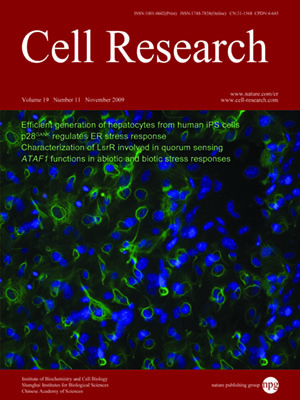
Volume 19, No 11, Nov 2009
ISSN: 1001-0602
EISSN: 1748-7838 2018
impact factor 17.848*
(Clarivate Analytics, 2019)
Volume 19 Issue 11, November 2009: 1258-1268
ORIGINAL ARTICLES
LsrR-binding site recognition and regulatory characteristics in Escherichia coli AI-2 quorum sensing
Ting Xue, Liping Zhao, Haipeng Sun, Xianxuan Zhou and Baolin Sun
Hefei National Laboratory for Physical Sciences at Microscale and School of Life Sciences, University of Science and Technology of China, Hefei, Anhui 230027, China
Correspondence: Baolin Sun,(sunb@ustc.edu.cn)
In quorum sensing (QS) process, bacteria regulate gene expression by utilizing small signaling molecules called autoinducers in response to a variety of environmental cues. Autoinducer 2 (AI-2), a QS signaling molecule proposed to be involved in interspecies communication, is produced by many species of gram-negative and gram-positive bacteria. In Escherichia coli and Salmonella typhimurium, the extracellular AI-2 is imported into the cell by a transporter encoded by the lsr operon. Upstream of the lsr operon, there is a divergently transcribed gene encoding LsrR, which was reported previously to repress the transcription of the lsr operon and itself. Here, we have demonstrated for the first time that LsrR represses the transcription of the lsr operon and itself by directly binding to their promoters using gel shift and DNase I footprinting assays. The β-galactosidase reporter assays further suggest that two motifs in both the lsrR and lsrA promoter regions are crucial for the LsrR binding. Furthermore, in agreement with the conclusion that phosphorylated AI-2 can relieve the repression of LsrR in previous studies, our data show that phospho-AI-2 renders LsrR unable to bind to its own promoter in vitro.
Cell Research (2009) 19:1258-1268. doi: 10.1038/cr.2009.91; published online 28 July 2009
FULL TEXT | PDF
Browse 1987


